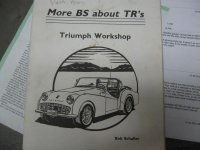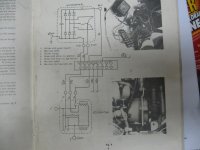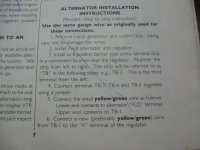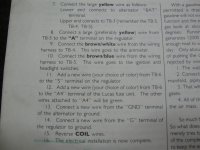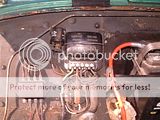mastaphixa
Jedi Trainee
Offline
I have done a search on this and similar subjects without finding help for my situation.
The car: 1960 TR3 converted to Negative ground and Motorcraft Alternator with external voltage regulator.
The problem:
1. Generator light is on bright with the engine running.
2. Battery shows the same voltage engine on or off.
The conversion:
I found what looks like the conversion performed to this car with documentation included with it, namely a document titled "More BS about TR's" by Bob Schaller. I have attached an image of the cover, wiring diagram and instruction for conversion that a previous owner had accomplished with this post.
My questions:
1. There are only 2 wires attached to the alternator.
a. Large Yellow attached to the BAT terminal on the Alternator.
b. Small Yellow/Green attached to the FIELD terminal on the Alternator.
The wiring diagram shows a wire from the STAT terminal on the Alternator to TB2. It's not connected to anything. This wire does not exist. I suspect there is an error in the wiring diagram or the instructions?
The wiring diagram shows a ground wire run from the Alternator to ground. Would the physical mounting of the Alternator to the block suffice for this?
Observations:
1. Revving the engine has no effect on battery voltage.
2. The belt is loose compared to the modern cars (Miatas) that I am used to, but is appropriate for this car from what I have read.
3. Placing a DC Voltmeter between TB 3 and ground produce 12.9 VDC at idle.
Thanks for any advice in advance.
The car: 1960 TR3 converted to Negative ground and Motorcraft Alternator with external voltage regulator.
The problem:
1. Generator light is on bright with the engine running.
2. Battery shows the same voltage engine on or off.
The conversion:
I found what looks like the conversion performed to this car with documentation included with it, namely a document titled "More BS about TR's" by Bob Schaller. I have attached an image of the cover, wiring diagram and instruction for conversion that a previous owner had accomplished with this post.
My questions:
1. There are only 2 wires attached to the alternator.
a. Large Yellow attached to the BAT terminal on the Alternator.
b. Small Yellow/Green attached to the FIELD terminal on the Alternator.
The wiring diagram shows a wire from the STAT terminal on the Alternator to TB2. It's not connected to anything. This wire does not exist. I suspect there is an error in the wiring diagram or the instructions?
The wiring diagram shows a ground wire run from the Alternator to ground. Would the physical mounting of the Alternator to the block suffice for this?
Observations:
1. Revving the engine has no effect on battery voltage.
2. The belt is loose compared to the modern cars (Miatas) that I am used to, but is appropriate for this car from what I have read.
3. Placing a DC Voltmeter between TB 3 and ground produce 12.9 VDC at idle.
Thanks for any advice in advance.

 Hi Guest!
Hi Guest!

 smilie in place of the real @
smilie in place of the real @
 Pretty Please - add it to our Events forum(s) and add to the calendar! >>
Pretty Please - add it to our Events forum(s) and add to the calendar! >> 
